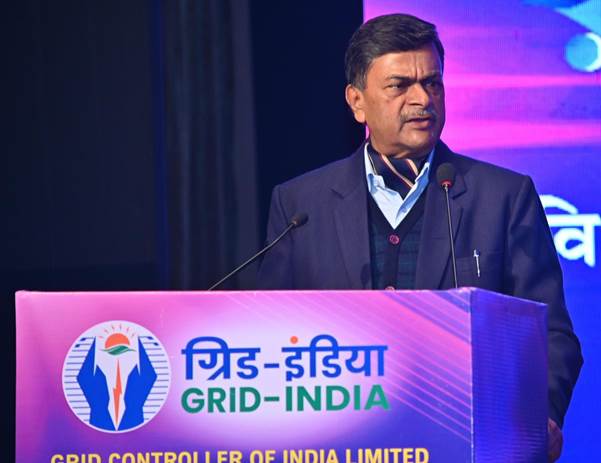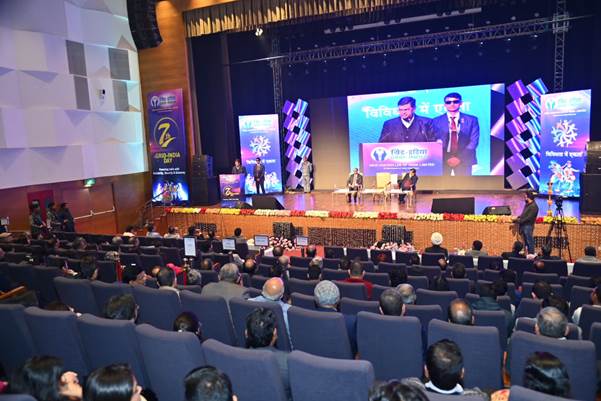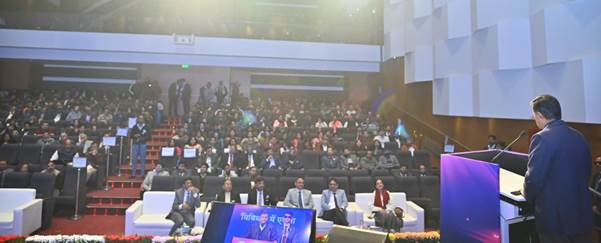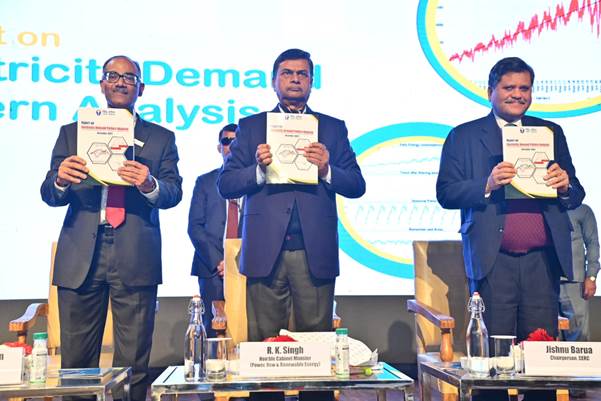7th Grid-India Day commemorates 7 years of independent functioning and contribution of Grid-India
The 7th Grid-India Day was celebrated in New Delhi today, 3rd January 2024, to commemorate seven years of independent functioning of Grid Controller of India Limited as a Central Public Sector Enterprise. The event was graced by the Union Minister for Power and New & Renewable Energy, Shri R. K. Singh; Chairperson, Central Electricity Regulatory Commission, Shri Jishnu Barua; CMD, GRID-INDIA, Shri S. R. Narasimhan; and other power sector stakeholders belonging to government and industry. The event served as a platform to recognize the contributions of Grid-India in shaping India’s power sector.
“Future growth will be highly disruptive, major challenge upon Grid-India as backbone of power sector”
Addressing the gathering, the Union Minister for Power and New & Renewable Energy Shri R. K. Singh exhorted the Grid-India employees to brace for future challenges, in line with the demands of a growing economy which aims to transition to increased share of renewable energy. “The growth up till now has been linear or sequential, but the future growth is going to be hugely disruptive. The rate at which the country is growing and the rate of transformation of power sector means that the future is going to be totally different.” The Minister said that the major challenge is going to be upon Grid-India since it is the backbone of the power sector, transferring power across the country and acting as the uniting force and the main troubleshooter for the power sector.

“Increasing share of renewable energy and distributed renewable energy pose new challenges”
Throwing light on the challenges, the Minister said that the future will witness introduction of new systems, increasing share of renewable energy and distributed renewable energy. “A lot of new systems are being introduced. Up till now, we have been able to integrate renewables, but going forward, the share of renewable capacity in total capacity will become larger and larger, posing greater challenges in integration. We are trying to reduce intermittence by adding storage to any future capacity addition to renewables. The other part of the challenge is that a lot of renewable energy is going to be distributed generation, with initiatives such as rooftop solar, thereby making consumers into prosumers. We are going to make cooking electric and electric mobility too is being promoted in a big way.”
“Think of what needs to be done if solar is to be put on every roof”
Emphasizing that Grid-India will need to face the brunt of meeting the challenges, since it is the organization which brings it all together, the Minister asked the employees to think of challenges arising in the light of ambitious goals for the nation. “Think of what needs to be done if solar is to be put on every roof, think of what will happen when cooking becomes totally electric, think of the scenario when vehicles need to be plugged in and plugged out.”
The Minister highlighted the need to put in place new systems and asked Grid-India employees to be ready for change. “Our demand is increasing rapidly; it is going to double by 2030 or even before that. Imagine going up from 243 GW to around 500 GW by 2030. We are adding a lot of transmission capacity, but we need to do more for a country the size of ours and for an economy which is growing this fast. The days of incremental straight-line growth are gone. Now, we think of the whole system and evolve in a direction which puts us ahead of any developed country, with initiatives such as the General Network Access.”

“Grid-India needs to adequately prepare for cybersecurity challenges”
Shri Singh said that while these challenges are ones we can anticipate and prepare for, challenges in the area of cybersecurity are those which we may not be as adequately prepared as we should be. “We need to be very careful. In previous years, we were not very careful about where from we procure our systems. Now, we have introduced the system of buying from trusted vendors only. Do not allow the internet to be connected to your system. Enemies will always be there; so, cybersecurity challenges are an ever-present danger which we need to prepare for and tackle. We need to have greater capacity for testing equipment when we purchase so that we are able to spot malware.”
“Bundling of energy will be a key part of the future energy systems”
Speaking of the future, the Minister said that bundling of energy will be a key part of the future energy systems. “The future is where thermal power and renewable power or hydro and renewable energy get bundled. Rules and regulations are meant to be changed to meet the future. We are going to transition in an orderly manner. The future is that we are going to become totally green.”

The Power Minister asked Grid-India officials to embrace change, professionalism and lead the nation to the promising future. “The future for India is going to be great. We have been the fastest growing economy in the world for the next 2-3 decades. We are going to be the third largest economy in 2027. Hence, I want all of you to be aware that the future is going to be a challenge for the power sector in meeting these growth needs. You need to think of the huge capacities which are being added and where they are being added. Start thinking about change. We need to be up to it.”
“Embrace of renewable energy and energy conservation are both important in energy transition”
In his address, Chairperson of the Central Electricity Regulatory Commission (CERC), Shri Jishnu Barua emphasized the pivotal role of the energy sector in shaping the future of the 21st century global landscape. He highlighted India’s prominent position as a strong advocate in the international arena for energy transition and the exploration of novel energy resources. Furthermore, Shri Barua acknowledged the crucial role of system operators as the eyes and ears of the Commission, emphasizing the Commission’s significant consideration of their perspectives.
Shri Barua elucidated on the dual facets of the ongoing energy transition in India. Firstly, he underscored the expeditious embrace of renewable energy sources, marking a significant stride towards a sustainable energy future. Additionally, he emphasized the importance of adopting effective methodologies for energy conservation, reflecting the nation’s commitment to responsible and efficient energy utilization.
“Grid-India’s capability would be in anticipating new challenges and keeping grid secure”
CMD, GRID-INDIA, Shri S. R. Narasimhan in his welcome address said: “The history of grid operations in India dates back to 1964 when five electricity boards were constituted. RLDCs have changed ownership over the years, and now under Grid-India, even as we synchronized regional grids to form a national grid. Today, I salute all predecessors for setting up a robust electricity grid.”
The CMD said that the name change from POSOCO to Grid Controller of India has been initiated by the Power Minister in 2022 and that it has been well-received both within India and abroad. He said that Grid-India is ready to take on new responsibilities whenever envisaged. “We strive to rise to the challenge of maintaining the stability of the grid, in line with the rising and growing power demand.” The CMD pointed out that the 7% – 8% annual growth demand in power, coupled with new loads such as e-cooking will place new challenges on capital adequacy front. “Supply chain management issues will pose a challenge. Grid-India’s capability would be in anticipating these challenges and keeping the grid secure.” The CMD thanked the Power Minister for administrative interventions to ensure effective functioning of electricity markets.
Launch of Grid-India Report on Electricity Demand Pattern Analysis
During the event, the Power Minister unveiled a report titled ‘Electricity Demand Pattern Analysis,’ compiled by Grid-India. The report seeks to offer insights into the diurnal, seasonal, and annual patterns of electricity demand, providing valuable information for strategic planning by both central and state-level power agencies. The report delves into seasonal fluctuations, time-of-day variations, day-of-week trends, and regional diversity, presenting a comprehensive understanding of the intricate electricity demand patterns.
The report can be accessed here.

Launch of Corporate Film and Corporate Anthem of Grid-India
The Minister, accompanied by esteemed guests, unveiled both the Corporate Film and Corporate Anthem of Grid-India. The film emphasizes Grid-India’s significance in the Indian Power Sector, while the Corporate Anthem effectively communicates the organization’s values, mission, and culture, fostering a collective sense of unity and pride among its employees. It is noteworthy that the creation of the Corporate Anthem involved the collaborative efforts of Grid-India’s employees.
The corporate film can be watched here and the corporate anthem can be watched here.
The Inter-Regional Load Despatch Centre Cultural Meet, centred around the theme of ‘Unity in Diversity,’ took place as part of the celebration. Teams from various Grid-India offices showcased their diverse cultures on stage. The event also included cultural performances and a felicitation ceremony honouring winners of Inter-RLDC Cultural Meet and contributors of Corporate Anthem.
The event was attended by guests from Ministry of Power, Ministry of New and Renewable Energy, CERC, Central Electricity Commission, RPC, NLDC, RLDCs and other stakeholders of Indian Power Sector.
The programme can be watched here.
GRID-INDIA day is observed on 3rd January to commemorate its independent functioning since 3rd January 2017, as a Central Public Sector Enterprise (CPSE) under Ministry of Power, after separating from POWERGRID as its subsidiary organization. GRID-INDIA is entrusted with the crucial responsibility of ensuring the integrated operation of the electricity grid in a reliable, efficient, and secure manner. Its structure comprises five Regional Load Despatch Centres (RLDCs) and the National Load Despatch Centre (NLDC).

